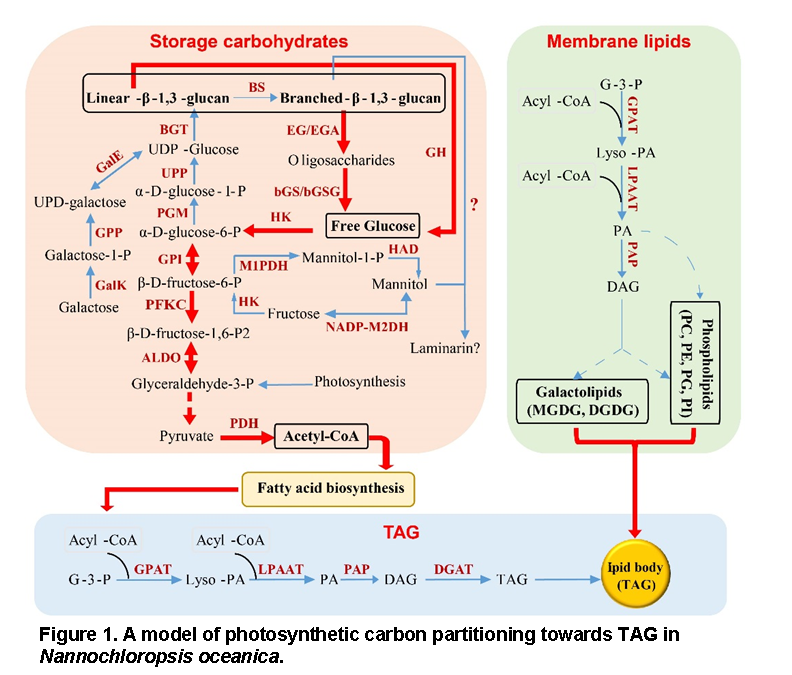Under stress conditions, microalgae can accumulate large quantities of oil, which can be converted to biodiesel. However, in microalgae, multiple forms of storage carbon products deprived from the photosynthetically fixed carbon can be found (such as water-soluble polysaccharides and starch). As biosynthesis of the multiple forms of storage compounds may require the same carbon precursors such as glucose and reducing power, understanding and tuning the partitioning of carbon precursors into the various forms of carbon storage are of key interest for rational metabolic engineering of industrial microalgae strains for improved oil production.
Recently, a team led by Dr. Xu (Single-Cell Center, Qingdao Institute of BioEnergy and Bioprocess Technology, Chinese Academy of Sciences) worked together with a team led by Dr. Han and Dr. Hu (Center for Microalgal Biotechnology and Biofuels, Institute of Hydrobiology, Chinese Academy of Sciences), unveiled the molecular mechanisms of photosynthetically fixed carbon into storage neutral lipids in microalgae under nitrogen-depleted conditions. These findings have implications in genetic engineering for enhanced oil production in this and related microalgae by taking advantage of this molecular mechanism. Related results have been published online in Algal Research on December 17th (Jia, et al, Algal Research, 2014).
In previous work, using industrial oleaginous microalgaeNannochloropsisas a model, this group reveals genetic background and evolution of microalgal oleaginous traits (Wang DM, et al, PLoS Genetics, 2014, 10(1):e1004094) and dynamics of oleaginousness at molecular level (Li J, et al, Plant Cell, 2014, 10.1105/tpc.113.121418). What is the dynamic relationship between carbohydrates and neutral lipids during the oleaginous process?

Jing Jia, a Ph.D. student (Single-Cell Center, Qingdao Institute of BioEnergy and Bioprocess Technology, Chinese Academy of Sciences), probed the crosstalk between carbohydrate metabolism and TAG accumulation in oleaginous microalga by tracking the temporal dynamics of lipidome, mono- and poly- sugar profiles, and transcripts of selected genes over a 14-day cultivation of Nannochloropsis under both nitrogen-depleted (N-) and nitrogen-replete (N+) conditions, and proposed a carbon partitioning model during the oleaginous process (Figure 1). Glucose, galactose and mannitol were the main mono-saccharides in Nannochloropsis and laminarin may be the storage polysaccharide that competes for carbon precursors with TAG. Transcriptional expression analysis revealed that the β-1,3-glucan degradation and pyruvate dehydrogenases pathways were the main forces that drive carbon flow to TAG synthesis. Furthermore, temporal changes of lipidomes and transcripts of glycerolipid biosynthetic and lipases genes were indicative of possible conversion of membrane lipids to TAG, especially under nitrogen deprivation conditions. These findings have implications in genetic engineering for enhanced oil production in this and related microalgae.
This work was funded by the Ministry of Science and Technology of China, the International Research Collaboration Program and the Young Investigator Program from National Natural Science Foundation of China and Initiative from ChineseAcademyof Sciences.